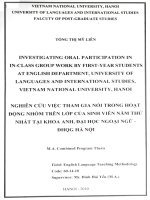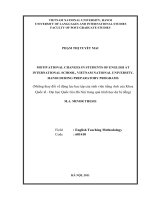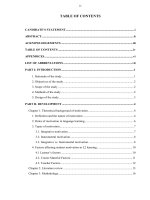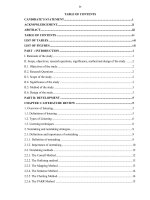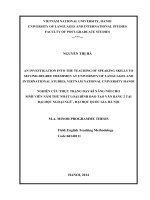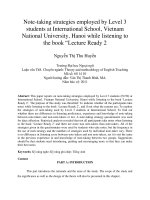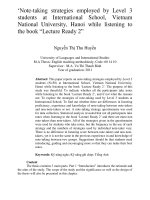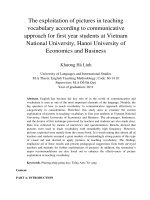Note-taking strategies employed by Level 3 students at International School, Vietnam National University, Hanoi while listening to the book “Lecture Ready 2
Bạn đang xem bản rút gọn của tài liệu. Xem và tải ngay bản đầy đủ của tài liệu tại đây (100.68 KB, 6 trang )
Note-taking strategies employed by Level 3
students at International School, Vietnam
National University, Hanoi while listening to
the book “Lecture Ready 2
Nguyễn Thị Thu Huyền
Trường Đại học Ngoại ngữ
Luận văn ThS. Chuyên ngành: Theory and methodology of English Teaching
Mã số: 60 14 10
Người hướng dẫn: Văn Thị Thanh Bình, MA.
Năm bảo vệ: 2011
Abstract: This paper reports on note-taking strategies employed by Level 3 students (N=50) at
International School, Vietnam National University, Hanoi while listening to the book „Lecture
Ready 2‟. The purpose of this study was threefold: To indicate whether all the participants take
notes while listening to the book „Lecture Ready 2‟, and if not what the reasons are; To explore
the strategies of note-taking used by Level 3 students at International School; To find out
whether there are differences in listening proficiency, experience and knowledge of note-taking
between note-takers and non-note-takers or not. A note-taking strategy questionnaire was used
for data collection. Statistical analysis revealed that not all participants take notes when listening
to the book „Lecture Ready 2‟ and there are more non note-takers than note-takers. All of the
strategies given in the questionnaire were used by students who take notes, but the frequency in
the use of each strategy and the numbers of strategies used by individual note-taker vary. There
is no difference in listening score between note-takers and non note-takers, yet it is not the same
in the previous experience in and knowledge of note-taking between two groups. Suggestions
should be that students need introducing, guiding and encouraging more so that they can make
their best notes.
Keywords: Kỹ năng nghe; Kỹ năng ghi chép; Tiếng Anh
Content
PART A: INTRODUCTION
This part introduces the rationale and the aims of the study. The scope of the study and
the significance as well as the design of the thesis will also be presented in this chapter.
I. Rationale
Listening to an English lecture has long been a difficult task to Vietnamese university
students who hardly had any chances to practice listening skills at lower- level schools. Note-
taking has long been considered an integral part of effective listening. Note-taking while
listening is considered one of the most important skills which language learners should master,
particularly as it helps to develop a sense of listening, allowing the reader to recognize main
ideas and to understand the organization of the material. Note-taking is believed to be an
important part of all of our learning interactions, from the most traditional, structured
experiences to highly informal, unstructured situations.‟ This is extremely significant for
Vietnamese learners who have been studying English listening skills traditionally in non - native
environment, and have just started to learn listening in communicative way.
But acquiring and mastering note-taking is likely to become a big hindrance to many
learners while they often find it difficult to exploit this skill in their learning experience. It is
especially true for General English students at International School, Vietnam National
University, Hanoi, whose English level are not very high. There are many reasons behind this
phenomenon. Students can be neither paying attention, nor write quickly enough. It can be due to
the fact that their spelling is not good enough or they cannot understand the teachers. Sometimes,
the lectures are in a too high level for their capabilities. However, the most common reason may
be students‟ shortage of note-taking strategies to use flexibly in listening to different lectures.
Therefore, the question of how to equip students with note-taking strategies so that they
can use the skill to support foreign language listening in any situation has become a matter of
teachers of English in general and teachers of English at International School in particular.
In Vietnam, there has so far been some research on note-taking strategies. However,
research on note-taking strategies employed by students at International School, VNU has not
been done yet.
As a teacher of English, I have dealt with many questions relating to note-taking which
are raised by my students or among my colleagues. For example, what are the effective ways of
taking notes? How to note down important information? Personally I found it necessary to
provide to them successful note-taking strategies to listen to the lecture. This is the major reason
why this topic interests me.
II. Scope, objectives, research questions, significance, method and design of the study
II.1. Objectives of the study
The objectives of the study are as follows:
- To indicate whether all the participants take notes while listening to the book „Lecture Ready
2‟, and if not what the reasons are.
- To explore the strategies of note-taking used by Level 3 students at International School.
- To find out whether there are differences in listening proficiency, experience and knowledge of
note-taking between note-takers and non-note-takers or not.
II.2. Research Questions
The study set out to seek answers to the following research questions:
♦ Do Level 3 students at International school take notes while listening to the book „Lecture
Ready 2‟? If not, what are the reasons?
♦ What are note-taking strategies employed by Level 3 students at International School?
♦ Are there any differences in listening proficiency, experience and knowledge of note-taking
between note-takers and non-note-takers
II.3. The scope of the study
The study is concerned with finding the students‟ note-taking strategies in listening to the
book “Lecture Ready 2”.
As note-taking strategies pointed out by individuals, institutions, and scholars are of a
variety, the present study only focuses on those which are considered to be popular and the most
easily-used by International School students.
II.4. Significance of the study
This study plays an important role in the identification of note-taking comprehension
strategies employed by Level 3 students at International School. Also, non-note-takers‟ reasons
for not taking notes are identified. Based on the findings, the study will have many important
implications for training Level 3 students of English at International School in taking notes.
II.5. Methods of the study
In order to achieve the aims of the study mentioned above, the descriptive method is the
main tool for analyzing the data, which is collected from the questionnaire.
After the data is analyzed and discussed, the findings will be showed and some
conclusions will be drawn and some suggestions will be raised in the thesis.
II.6. Design of the study
This thesis consists of three parts:
Part A: is the Introduction, which presents the rationale, the objectives, the research questions,
the scope, the significance, the methods and the design of the study.
Part B: consists of four chapters.
Chapter 1: deals with a theoretical background. It starts with listening in general including
definitions, types and techniques. The next is note-taking and its importance in language
teaching, then an overview of some note-taking methods - their advantages and disadvantages in
applying in the classroom. Last, the previous studies on note-taking strategies are briefly
summarized.
Chapter 2: presents the survey questionnaires. Firstly, there is a description about the present
situation of English listening teaching and learning at International School. Secondly, the
methodology is performed in the study. It provides participants, instruments and data analysis.
Chapter 3: presents the findings.
Chapter 4: analyzes and discusses the findings of the study are
Part C: is about the conclusion and suggestions for a further study.
This part has presented an overview of the study which includes the rational for the study,
the aims, the research questions, the scope, the significance as well as the design of the study.
The next chapter will review the relevant literature which provides a theoretical framework for
the study.
References
1. Anderson, A. & Lynch, T. (1988), Listening, Oxford University Press.
2. Boon, O. (1989), "Notetaking for hearing and hearing impaired students", Journal of Reading,
pp. 523-536
3. Buck, G. (2001), Assessing Listening, Cambridge University Press, Cambridge.
4. Carrier, C. & Titus, A. (1981). “Effects of notetaking pretraining and test mode expectations
on learning from lecture”, American Educational Research Journal, 18 (4),
pp. 385-397.
5. Castallo, R. (1976), "Listening Guide - A First step towards notetaking and listening stills",
Journal of Reading, (19), pp.289-290.
6. Dunkel, P. (1985), "Listening and Notetaking; What Is the Effect of Pretraining in
Notetaking?", TESOL Newsletter, pp. 30-31.
7. Dunkel, P. and S. Davy (1989), "The Heuristic of Lecture Notetaking: Perceptions of
American and International Students Regarding the Value and Practice of Notetaking", English
for Specific Purposes, 8, pp. 33-50.
8. Harmer, J. (2001), The Practice of English Language Teaching, Longman.
9. O‟Malley, J.M, Chamot, A.U & Kupper, L. (1989) Listening Comprehension strategies in
Second Language acquisition, Applied Linguistics, 10 (4).
10. Ornstein, A.C. (1994), “Homework, studying, and notetaking: Essential skills for students”,
NASSP Bulletin, 78 (558), pp. 58-70.
11. Otto, S. A. (1979),"Listening for Note-taking in EST", TESOL Quarterly, pp. 319-328.
12. Palmatier, R.A. (1971), “Comparison of four note-taking procedures”, Journal of Reading,
14 (4), pp. 235-240.
13. Rost, M. (1990), Listening in Language Learning, Longman, London.
14. Spires, H.A. & Stone P. D. (1989), “The directed notetaking activity: A self-questioning
approach”, Journal of Reading, 33 (1), pp. 36-39.
15. Ur, P. (1984), Teaching Listening Comprehension, Cambridge University Press, Cambridge.
16. Southern Nazarene University (1999) “The Professor in the Classroom," The master teacher
17. Wilga, R. (1986), Teaching Foreign Language Skill, The University of Chicago Press.
